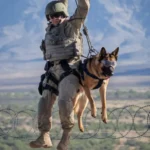In a heartwarming tradition, retired military working dogs (MWDs) often find their forever homes with their former handlers.

At Fort Sill, two soldiers from the 902nd Military Working Dog Detachment recently adopted the dogs they once partnered with on military missions.
Staff Sgt. Daniel Franklin adopted his beloved dog, Sue, while Sgt. Jarred Palmer brought home Zzazu, who had served alongside him for five years.
Adopting MWDs is the Rule
Adoption of these loyal canines by their handlers is not unusual—it’s the rule. When an MWD retires due to age or medical conditions, every effort is made to adopt them out, preferably to their handlers.
Euthanasia is only considered as a last resort for dogs suffering from terminal illnesses, a far cry from earlier practices when these brave dogs were considered excess equipment.
Canine Heroes with Special Needs
Many of these retired dogs, like Zzazu, deal with conditions such as canine PTSD (C-PTSD), similar to their human counterparts.
Zzazu, a Belgian Malinois, and Sue, a German Shepherd, served with exceptional loyalty, but their retirement brings new challenges, like dealing with their age-related ailments. Zzazu’s PTSD is a reminder that these military heroes also bear emotional scars from their service.
Not Your Average Dog
Military dogs are highly trained, sometimes for lethal purposes, and possess traits that might not make them ideal for every household.
According to petsforpatriots.org, some MWDs may not be suitable for families with small children or other pets due to their aggressive tendencies or specialized training. For this reason, decommissioned MWDs are never surrendered to public shelters or rescue organizations.
Rigorous Training and Deployment
Both Franklin and Palmer are part of the 31K military occupational specialty (MOS), which focuses on military dog handling.
Before becoming handlers, they underwent extensive training, including combat training and specialized instruction at Joint Base San Antonio – Lackland, where the dogs also receive several months of rigorous training. Today, 2,500 military dogs serve across the world, continuing a legacy that began during the Revolutionary War.
Contents
Conclusion
The story of these retired military working dogs highlights not just their loyalty in service but also the special bond they share with their handlers.
After years of protecting and serving, these dogs deserve a loving home where they can enjoy their retirement. By adopting their former partners, handlers ensure that these canine heroes live out their days with the care and companionship they’ve earned.
FAQs
- What happens to military working dogs after they retire?
Retired military working dogs are typically adopted by their former handlers. If the handlers cannot adopt them, they are offered to the public, but euthanasia is only considered for dogs with terminal illnesses. - Are military working dogs suitable for families?
Not always. These dogs are highly trained for military purposes and may display aggressive behavior or have specific triggers that make them unsuitable for homes with children or other pets. - How long do military dogs serve?
Military dogs typically serve until they are medically unfit or reach an age where they can no longer perform their duties, such as in the case of Sue, who retired due to a spinal condition. - What breeds are most commonly used for military working dogs?
The most common breeds used for military work are German Shepherds, Belgian Malinois, and Dutch Shepherds, all of which are smart, aggressive, and loyal—traits ideal for military tasks. - Where do military dogs receive their training?
Military working dogs and their handlers undergo extensive training at Joint Base San Antonio – Lackland in Texas, where the dogs are trained in explosives detection, obedience, and patrolling. - Why don’t military dogs get surrendered to shelters?
Due to their specialized training and temperament, retired military working dogs are not placed in shelters. Instead, they are carefully rehomed with handlers or families who can manage their unique needs.







